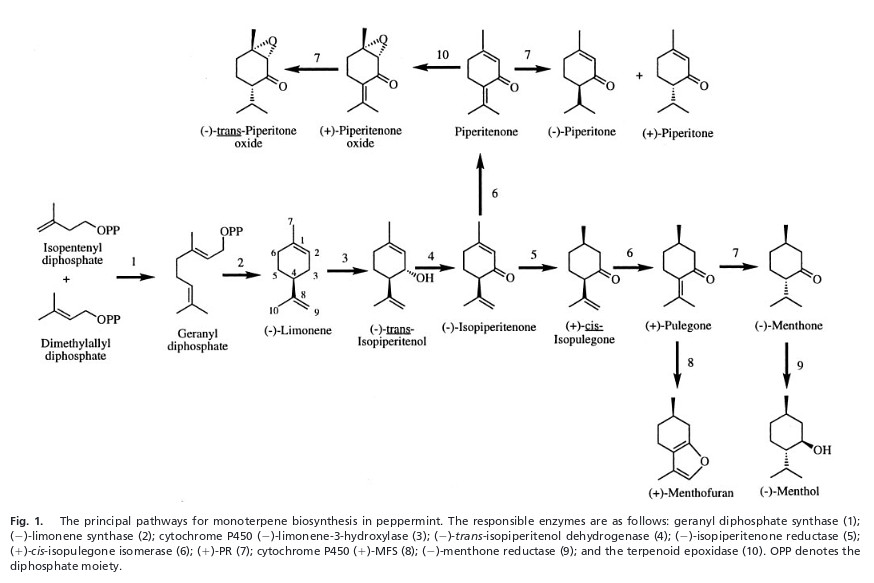Dies ist eine alte Version des Dokuments!
Mentha × piperita L. - Lamiaceae - peppermint, Pfefferminze
„Source of peppermint oil, an essential oil used for flavoring confectionary, candies, liqueur, and chewing gum. The dried plant is used medicinally as a carminative, nervine, and stimulant, while menthol is used in nasal sprays. A hybrid: Mentha aquatica Linnaeus X M. spicata Linnaeus.“ http://efloras.org/florataxon.aspx?flora_id=2&taxon_id=210001264
„Peppermint (Mentha piperita L.) is one of the most widely consumed single ingredient herbal teas, or tisanes. Peppermint tea, brewed from the plant leaves, and the essential oil of peppermint are used in traditional medicines. Evidence-based research regarding the bioactivity of this herb is reviewed. The phenolic constituents of the leaves include rosmarinic acid and several flavonoids, primarily eriocitrin, luteolin and hesperidin. The main volatile components of the essential oil are menthol and menthone. In vitro, peppermint has significant antimicrobial and antiviral activities, strong antioxidant and antitumor actions, and some antiallergenic potential. Animal model studies demonstrate a relaxation effect on gastrointestinal (GI) tissue, analgesic and anesthetic effects in the central and peripheral nervous system, immunomodulating actions and chemopreventive potential. Human studies on the GI, respiratory tract and analgesic effects of peppermint oil and its constituents have been reported. Several clinical trials examining the effects of peppermint oil on irritable bowel syndrome (IBS) symptoms have been conducted. However, human studies of peppermint leaf are limited and clinical trials of peppermint tea are absent. Adverse reactions to peppermint tea have not been reported, although caution has been urged for peppermint oil therapy in patients with GI reflux, hiatal hernia or kidney stones.“
[A review of the bioactivity and potential health benefits of peppermint tea (Mentha piperita L.). McKay, D. L., Blumberg, J. B., Phytotherapy Research, Vol.20(8), 2006, 619-633]
Superior qualities of M.piperita essential oil are due to the optimal concentration of menthol and menthyl acetate and the low amount of menthofuran (trace).
[Essential oil composition of Mentha x piperita L. from different environments of north India. Shahi, A. K., Chandra, S., Dutt, P., Kaul, B. L., Tava, A., Avato, P., Flavour and fragrance journal, Vol.14(1), 1999, 5-8]
„In the search for sustainable agricultural methods for industrial crops, peppermint (Mentha piperita) was strip intercropped with soybean (Glycine max). Intercropping peppermint with soybean resulted in yield and quality increases in the essential oil, compared to sole peppermint cultivation. The yield was higher by about 50% on an equal land area basis and higher percentages of menthol and lower percentages of menthofuran and menthyl acetate improved the quality of the oil.“
[Essential oil yield in peppermint/soybean strip intercropping. Maffei, M., Mucciarelli, M., Field crops research, Vol.84(3), 2003, 229-240]
„(+)-Pulegone is a central intermediate in the biosynthesis of (-)-menthol, the most significant component of peppermint essential oil. Depending on environmental conditions, this branch point metabolite may be reduced to (-)-menthone en route to menthol, by pulegone reductase (PR), or oxidized to (+)-menthofuran, by menthofuran synthase.“
 [Menthofuran regulates essential oil biosynthesis in peppermint by controlling a downstream monoterpene reductase. Mahmoud, S. S., Croteau, R. B., Proceedings of the National Academy of Sciences, Vol.100(24), 2003, 14481-14486]
http://www.pnas.org/content/100/24/14481.full.pdf
[Menthofuran regulates essential oil biosynthesis in peppermint by controlling a downstream monoterpene reductase. Mahmoud, S. S., Croteau, R. B., Proceedings of the National Academy of Sciences, Vol.100(24), 2003, 14481-14486]
http://www.pnas.org/content/100/24/14481.full.pdf
„Peppermint (Mentha × piperita L.) was transformed with various gene constructs to evaluate the utility of metabolic engineering for improving essential oil yield and composition… The most promising results were obtained by transforming plants expressing an antisense version of (+)-menthofuran synthase, which is critical for adjusting the levels of specific undesirable oil constituents, with a construct for the overexpression of the MEP pathway gene 1-deoxy-D-xylulose 5-phosphate reductoisomerase (up to 61% oil yield increase over wild-type controls with low levels of the undesirable side-product (+)-menthofuran and its intermediate (+)-pulegone). Elite transgenic lines were advanced to multiyear field trials, which demonstrated consistent oil yield increases of up to 78% over wild-type controls and desirable effects on oil composition under commercial growth conditions. The transgenic expression of a gene encoding (+)-limonene synthase was used to accumulate elevated levels of (+)-limonene, which allows oil derived from transgenic plants to be recognized during the processing of commercial formulations containing peppermint oil. Our study illustrates the utility of metabolic engineering for the sustainable agricultural production of high quality essential oils at a competitive cost.“
[Improving peppermint essential oil yield and composition by metabolic engineering. Lange, B. M., Mahmoud, S. S., Wildung, M. R., Turner, G. W., Davis, E. M., Lange, I., Croteau, R. B., Proceedings of the National Academy of Sciences, Vol.108(41), 2011, 16944-16949]

